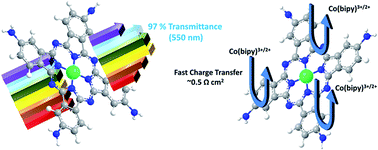Highly transparent tetraaminophthalocyanine polymer films for DSSC cathodes†
Abstract
An inexpensive, transparent, catalytic, and highly stable material is the holy grail for a dye sensitized solar cell (DSSC) cathode. Despite a near exponential increase in research effort on DSSC cathodes, materials approaching this ideal have yet to be found. Transparent cathodes allow for front and back illumination of the solar cell, enable alternative anode materials and cell designs, and are important both for fundamental research and commercialization of DSSCs. In this work, thin polymeric films of nickel tetraminophthalocyanine (NiTAPc) were tested as a catalytic cathode material in Co(Bipy)-mediated DSSCs. The thin films are highly transparent with a transmittance at 550 nm (T550) of over 95% while maintaining an Rct value below 1.3 Ω cm2. The NiTAPc films are inexpensive, fast and easy to generate, and stable to 2000 cyclic voltammetry cycles. Long-term film stability was not realized, and a rise in the Rct over time (days) occurred. However, poly-NiTAPc still represents one of the most transparent and catalytic materials reported to date. While historically phthalocyanines (Pc) have been studied as a dye/sensitizer, this first report of phthalocyanine use as a cathode material demonstrates they have utility on both sides of the DSSC.



 Please wait while we load your content...
Please wait while we load your content...